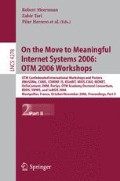Abstract
The Health-e-Child project aims to develop an integrated healthcare platform for European paediatrics. In order to achieve a comprehensive view of children’s health, a complex integration of biomedical data, information, and knowledge is necessary. Ontologies will be used to formally define this domain knowledge and will form the basis for the medical knowledge management system. This paper introduces an innovative methodology for the vertical integration of biomedical knowledge. This approach will be largely clinician-centered and will enable the definition of ontology fragments, connections between them (semantic bridges) and enriched ontology fragments (views). The strategy for the specification and capture of fragments, bridges and views is outlined with preliminary examples demonstrated in the collection of biomedical information from hospital databases, biomedical ontologies, and biomedical public databases.
An erratum to this chapter can be found at http://dx.doi.org/10.1007/11915072_109.
Access this chapter
Tax calculation will be finalised at checkout
Purchases are for personal use only
Preview
Unable to display preview. Download preview PDF.
References
Freund, J., et al.: Health-e-Child: An Integrated Biomedical Platform for Grid-Based Pediatrics. Studies in Health Technology & Informatics 120, 259–270 (2006)
Goble, C., et al.: Transparent Access to Multiple Bioinformatics Information Sources (TAMBIS). IBM System Journal 40(2), 532–551 (2001)
Kohler, J., Phillipi, S., Lange, M.: SEMEDA: ontology based semantic integration of biological databases. Bioinformatics 19(18) (2003)
The Unified Medical Language System (UMLS) fact sheet available at the National Institutes of Health Library of Medicine, http://www.nlm.nih.gov/pubs/factsheets/umls.html
Perez-Roy, D., et al.: ONTOFUSION: Ontology-based integration of genomic and clinical databases. Computers in Biology & Medicine 36(7-8) (2006)
Stevens, R., Robinson, A., Goble, C.A.: myGrid: Personalised Bioinformatics on the Information Grid. Bioinformatics 19(suppl. 1), i302–i304 (2003)
Oliveira, I., et al.: On the Requirements of Biomedical Information Tools for Health Applications: The INFOGENMED Case Study. In: BioENG 2003, Lisbon, Portugal (2003)
Sanz, I., Mesiti, M., Guerrini, G., Berlanga, R.: ArHeX: An Approximate Retrieval System for Highly Heterogeneous XML Document Collections. In: Ioannidis, Y., Scholl, M.H., Schmidt, J.W., Matthes, F., Hatzopoulos, M., Böhm, K., Kemper, A., Grust, T., Böhm, C. (eds.) EDBT 2006. LNCS, vol. 3896, pp. 1186–1189. Springer, Heidelberg (2006)
Sanz, I., Mesiti, M., Guerrini, G., Llavori, R.B.: Highly Heterogeneous XML Collections: How to Retrieve Precise Results? In: Larsen, H.L., Pasi, G., Ortiz-Arroyo, D., Andreasen, T., Christiansen, H. (eds.) FQAS 2006. LNCS (LNAI), vol. 4027, pp. 232–244. Springer, Heidelberg (2006)
Jiménez, E., Berlanga, R., Sanz, I., Aramburu, M.J., Danger, R.: OntoPathView: A Simple View Definition Language for the Collaborative Development of Ontologies. In: Artificial Intelligence Research and Development, pp. 429–436. IOS Press, Amsterdam (2005)
Noy, N.F.: Semantic Integration: A Survey of Ontology Based Approaches. In: ACM SIGMOD Record, Special Issue on Semantic integration (2004)
Bouquet, Giunchiglia, F., Van Harmelen, F., Serafini, L., Stuckenschmidt, H.: Contextualizing ontologies. Journal of Web Semantics 1(4), 325–343 (2004)
Cuenca-Grau, Parsia, B., Sirin, E.: Combining OWL Ontologies using E-Connections. Journal of Web Semantics 4(1), 40–59 (2005)
Danger, R., Berlanga, R., Ruíz-Shulcloper, J.: CRISOL: An approach for automatically populating a Semantic Web from Unstructured Text Collections. In: Galindo, F., Takizawa, M., Traunmüller, R. (eds.) DEXA 2004. LNCS, vol. 3180, pp. 243–252. Springer, Heidelberg (2004)
Author information
Authors and Affiliations
Editor information
Editors and Affiliations
Rights and permissions
Copyright information
© 2006 Springer-Verlag Berlin Heidelberg
About this paper
Cite this paper
Jimenez-Ruiz, E. et al. (2006). The Management and Integration of Biomedical Knowledge: Application in the Health-e-Child Project (Position Paper). In: Meersman, R., Tari, Z., Herrero, P. (eds) On the Move to Meaningful Internet Systems 2006: OTM 2006 Workshops. OTM 2006. Lecture Notes in Computer Science, vol 4278. Springer, Berlin, Heidelberg. https://doi.org/10.1007/11915072_8
Download citation
DOI: https://doi.org/10.1007/11915072_8
Publisher Name: Springer, Berlin, Heidelberg
Print ISBN: 978-3-540-48273-4
Online ISBN: 978-3-540-48276-5
eBook Packages: Computer ScienceComputer Science (R0)

